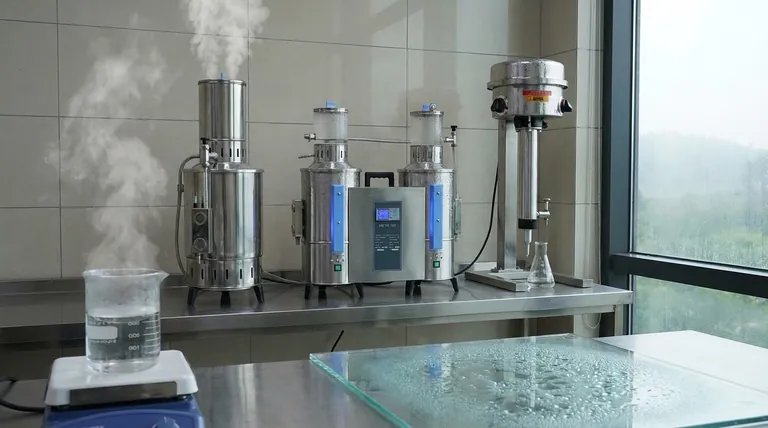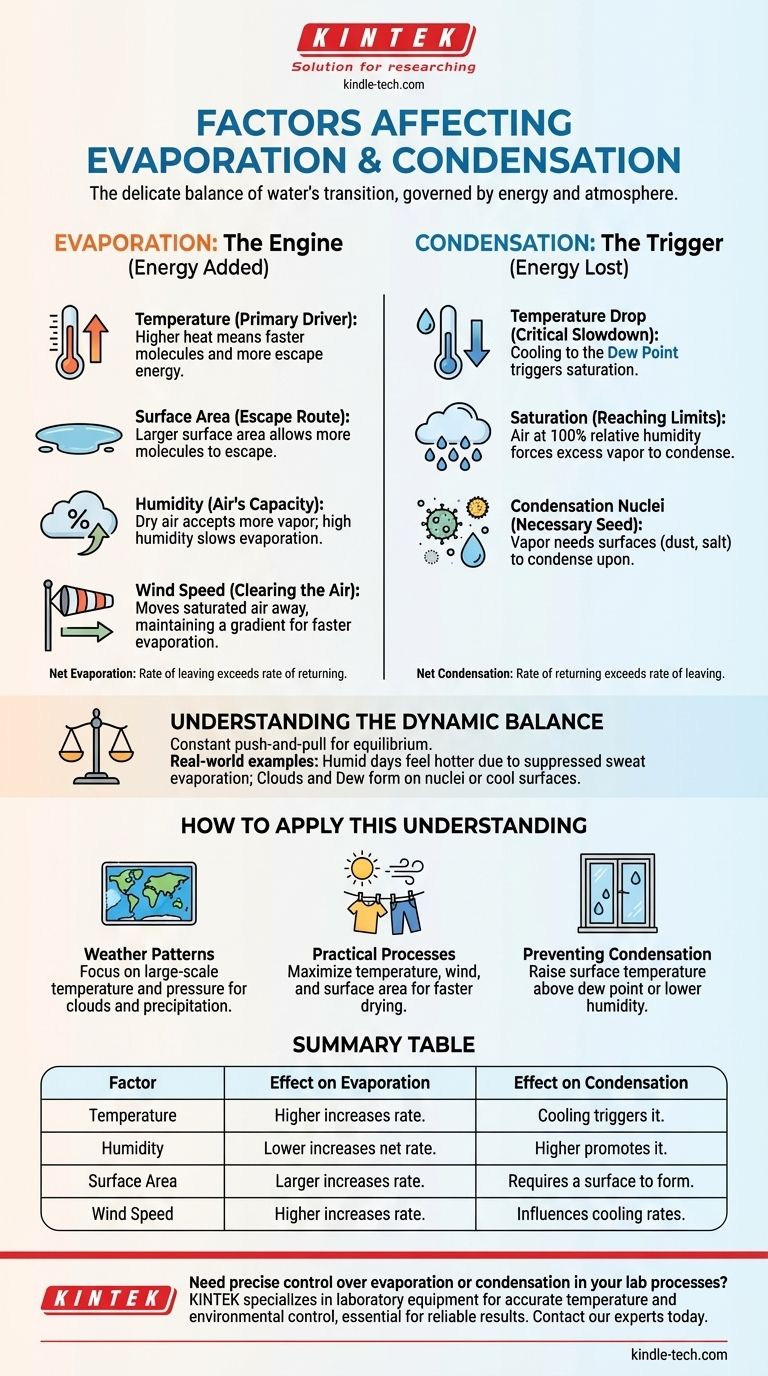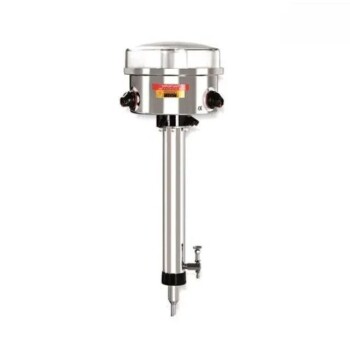Der Übergang von Wasser zwischen flüssigem und gasförmigem Zustand wird durch ein empfindliches Gleichgewicht von Energie und atmosphärischen Bedingungen bestimmt. Für die Verdunstung sind die Schlüsselfaktoren Temperatur, Oberfläche, Luftfeuchtigkeit und Windgeschwindigkeit. Für die Kondensation sind die kritischen Faktoren ein Temperaturabfall bis zum Taupunkt, die bereits in der Luft vorhandene Wasserdampfmenge und das Vorhandensein von Oberflächen, die als Kondensationskerne bekannt sind.
Verdunstung ist im Grunde ein energiegetriebener Prozess, der es dem Wasser ermöglicht zu entweichen, während Kondensation die Freisetzung dieser Energie ist, wenn Wasser in einen flüssigen Zustand zurückkehrt. Das Verständnis dieses Energieaustauschs ist der Schlüssel zum Verständnis, warum und wann jeder Prozess stattfindet.

Der Motor der Verdunstung: Energie und Raum hinzufügen
Verdunstung ist der Prozess, bei dem flüssiges Wasser genügend Energie aufnimmt, um in einen gasförmigen Zustand oder Wasserdampf überzugehen. Die Geschwindigkeit, mit der dies geschieht, wird durch mehrere miteinander verbundene Faktoren gesteuert.
Temperatur: Der primäre Treiber
Wärme ist eine Form von Energie. Wenn die Temperatur des Wassers steigt, bewegen sich seine Moleküle schneller und mit mehr Energie.
Diese erhöhte kinetische Energie ermöglicht es mehr Molekülen, die Bindungen zu überwinden, die sie im flüssigen Zustand zusammenhalten, und von der Oberfläche in die Luft als Dampf zu entweichen.
Oberfläche: Der Fluchtweg
Verdunstung findet nur an der Oberfläche einer Flüssigkeit statt. Je größer die der Luft ausgesetzte Oberfläche ist, desto mehr Moleküle können entweichen.
Deshalb verdunstet eine dünn auf dem Bürgersteig verteilte Pfütze viel schneller als die gleiche Menge Wasser in einem tiefen Glas.
Luftfeuchtigkeit: Die Aufnahmekapazität der Luft für Wasser
Die relative Luftfeuchtigkeit misst, wie viel Wasserdampf sich derzeit in der Luft befindet, verglichen mit der maximalen Menge, die sie bei dieser Temperatur halten könnte.
Wenn die Luft bereits mit Wasser gesättigt ist (100 % relative Luftfeuchtigkeit), gibt es wenig "Platz" für weiteren Dampf. Dies verlangsamt die Netttoverdunstungsrate erheblich. Trockene Luft hingegen nimmt bereitwillig mehr Wasserdampf auf.
Windgeschwindigkeit: Die Luft reinigen
Wenn Wasser verdunstet, bildet sich eine dünne Schicht feuchter Luft direkt über der Wasseroberfläche. Dies kann die weitere Verdunstung verlangsamen.
Wind bläst diese gesättigte Schicht weg und ersetzt sie durch trockenere Luft. Dies hält einen steilen Konzentrationsgradienten aufrecht und fördert eine schnellere und kontinuierlichere Verdunstungsrate.
Der Auslöser für Kondensation: Energie verlieren und eine Oberfläche finden
Kondensation ist der umgekehrte Prozess der Verdunstung. Sie tritt auf, wenn Wasserdampf in der Luft abkühlt und wieder zu flüssigem Wasser wird, wobei die während der Verdunstung aufgenommene Energie freigesetzt wird.
Temperaturabfall: Die kritische Verlangsamung
Damit Kondensation stattfindet, muss die Luft bis zu ihrem Taupunkt abkühlen. Dies ist die Temperatur, bei der die Luft mit dem enthaltenen Wasserdampf vollständig gesättigt ist.
Wenn die Luft abkühlt, verlangsamen sich ihre Moleküle. Sobald sie langsam genug sind, können die schwachen Anziehungskräfte zwischen ihnen sie wieder zu flüssigen Tröpfchen zusammenziehen.
Die Rolle der Sättigung
Kondensation ist eine direkte Folge davon, dass die Luft 100 % relative Luftfeuchtigkeit erreicht. Zu diesem Zeitpunkt kann die Luft bei ihrer aktuellen Temperatur einfach kein Wasser mehr in gasförmiger Form halten.
Jede weitere Abkühlung oder die Zugabe von mehr Wasserdampf wird einen Teil dieses Dampfes dazu zwingen, zu einer Flüssigkeit zu kondensieren.
Kondensationskerne: Ein notwendiger Keim
Wasserdampf benötigt eine nicht-gasförmige Oberfläche, auf der er kondensieren kann. In der Atmosphäre sind dies mikroskopisch kleine Staub-, Salz-, Pollen- oder Schadstoffpartikel.
Diese Partikel werden Kondensationskerne genannt und dienen als "Keime", um die sich Wolkentröpfchen bilden. Am Boden bildet sich Kondensation als Tau auf größeren Oberflächen wie Gras, Fenstern oder einer kalten Limonadendose, die unter den Taupunkt abgekühlt sind.
Das dynamische Gleichgewicht verstehen
Verdunstung und Kondensation sind keine isolierten Ereignisse. Sie befinden sich in einem ständigen Wechselspiel, das ein Gleichgewicht anstrebt. Das Erkennen ihres Zusammenspiels ist entscheidend für das Verständnis realer Phänomene.
Das Konzept der Nettoverdunstung
Selbst wenn wir sehen, wie eine Pfütze schrumpft, kondensiert immer noch etwas Wasserdampf aus der Luft zurück in die Pfütze.
Was wir als "Verdunstung" beobachten, ist tatsächlich Nettoverdunstung, was bedeutet, dass die Rate der Moleküle, die die Flüssigkeit verlassen, größer ist als die Rate der Moleküle, die zurückkehren. Das Gegenteil gilt für die Nettokondensation.
Warum sich feuchte Tage heißer anfühlen
Unser Körper kühlt sich durch Schwitzen ab. Die Verdunstung dieses Schweißes entzieht unserer Haut Wärme.
An einem heißen, feuchten Tag unterdrückt die hohe Konzentration von Wasserdampf in der Luft die Verdunstungsrate. Da unser Schweiß nicht effizient verdunsten kann, verlieren wir unseren primären Kühlmechanismus und fühlen uns heißer.
Wie Wolken und Tau entstehen
Diese beiden Phänomene veranschaulichen perfekt die Prinzipien der Kondensation. Wolken bilden sich, wenn eine Luftmasse aufsteigt, sich ausdehnt und in großer Höhe auf ihren Taupunkt abkühlt, wobei sie an luftgetragenen Kernen kondensiert.
Tau bildet sich, wenn eine Oberfläche am Boden, wie ein Grashalm, Wärme abstrahlt und über Nacht unter den Taupunkt der Umgebungsluft abkühlt, wodurch Dampf direkt darauf kondensiert.
Wie man dieses Verständnis anwendet
Ihr spezifisches Ziel bestimmt, welche Faktoren am wichtigsten zu berücksichtigen sind.
- Wenn Ihr Hauptaugenmerk auf Wettermustern liegt: Konzentrieren Sie sich auf großräumige Temperaturänderungen und Luftdrucksysteme, die Luftmassen zum Aufsteigen und Abkühlen bringen und Kondensation (Wolken und Niederschlag) verursachen.
- Wenn Ihr Hauptaugenmerk auf einem praktischen Prozess liegt (z. B. Wäschetrocknen): Sie sollten die Faktoren maximieren, die die Verdunstung beschleunigen – Temperatur erhöhen (Sonnenlicht), Wind erhöhen (eine Brise) und Oberfläche vergrößern (Kleidung ausbreiten).
- Wenn Ihr Hauptaugenmerk auf der Vermeidung unerwünschter Kondensation liegt (an Fenstern oder Geräten): Sie müssen entweder die Temperatur der Oberfläche erhöhen, damit sie über dem Taupunkt bleibt, oder die Menge an Wasserdampf in der Luft reduzieren (Luftfeuchtigkeit senken).
Indem Sie diese Kernprinzipien verstehen, erlangen Sie die Fähigkeit, das Verhalten von Wasser in unzähligen natürlichen und technischen Systemen vorherzusagen und sogar zu kontrollieren.
Zusammenfassungstabelle:
| Faktor | Auswirkung auf die Verdunstung | Auswirkung auf die Kondensation |
|---|---|---|
| Temperatur | Höhere Temperatur erhöht die Rate. | Abkühlung bis zum Taupunkt löst Kondensation aus. |
| Luftfeuchtigkeit | Niedrigere Luftfeuchtigkeit erhöht die Nettoverdunstung. | Höhere Luftfeuchtigkeit/Sättigung fördert die Kondensation. |
| Oberfläche | Größere Fläche erhöht die Rate. | Benötigt eine Oberfläche (z. B. Kerne, Gras) zur Bildung. |
| Windgeschwindigkeit | Höhere Geschwindigkeit erhöht die Rate durch Entfernen feuchter Luft. | Weniger direkter Einfluss, kann aber die Abkühlraten beeinflussen. |
Benötigen Sie präzise Kontrolle über Verdunstung oder Kondensation in Ihren Laborprozessen? KINTEK ist spezialisiert auf Laborgeräte und Verbrauchsmaterialien, die die genaue Temperatur- und Umgebungsregelung bieten, die für zuverlässige Ergebnisse unerlässlich ist. Egal, ob Sie neue Materialien entwickeln oder kritische Analysen durchführen, unsere Lösungen helfen Ihnen, diese grundlegenden Phasenübergänge zu meistern. Kontaktieren Sie noch heute unsere Experten, um die richtige Ausrüstung für Ihre spezifischen Laboranforderungen zu finden.
Visuelle Anleitung

Ähnliche Produkte
- Wandmontierte Wasserdestillationsanlage
- Verdampferschale für organische Materie
- Verdampfungsschale für organische Substanz
- Labor-Tisch-Wasserumlauf-Vakuumpumpe für Laboranwendungen
- Vakuum-Kältesynthese-Kühler Indirekter Kältesynthese-Kühler
Andere fragen auch
- Was sind die Methoden der Trennung und Reinigung? Meistern Sie die Schlüsseltechniken für Ihr Labor
- Was ist die Delta-20-Regel der Verdunstung? Sicher und effektiv sprühen lernen
- Bei welcher Temperatur findet Verdunstung statt? Entdecken Sie die Geheimnisse zur Steuerung der Verdunstungsrate
- Welche 4 Faktoren beeinflussen die Verdampfungsrate? Master Control für Labor- und Industrieprozesse
- Was ist der Unterschied zwischen THC-Extrakt und Destillat? Ein Leitfaden zu Vollspektrum vs. reiner Potenz




